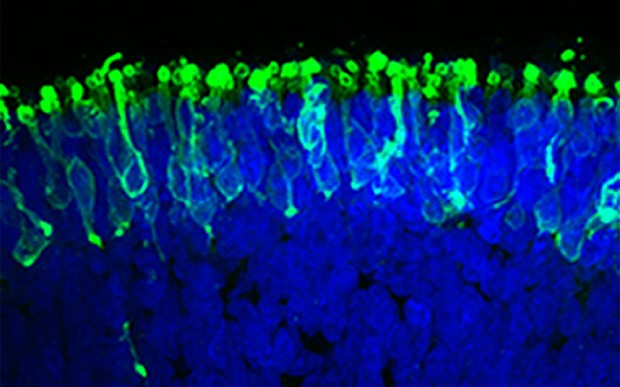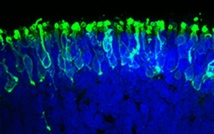Drugs are being used to halt some age-related forms of blindness, and in lab dishes, stem cells are being coaxed into forming retinal tissue in early proof-of-concept work.
"Things that were thought impossible a few years ago are a reality today," Maria Canto-Soler, director of the Retinal Degeneration Research Centre at Johns Hopkins University in the United States told AFP.
"It wouldn't be appropriate to say that we will find ways to cure retinal degenerative diseases in just a few more years, but we are surely on the right track... it is just a matter of time."
Retinal degenerative diseases like retinitis pigmentosa (RP) affect more than 30 million people around the world, according to the Foundation Fighting Blindness (FFB), based in Columbia, Maryland.
The tally includes age-related macular degeneration (AMD), which is the leading cause of blindness in people over 50 in developing countries, and Usher syndrome which is the main cause of combined deafness and blindness.
Scientists hope that soon, diagnosis with a degenerative retinal disease won't amount to a sentence of life-long disability.
No longer in the realm of science fiction, bionic retinas are already changing the lives of several dozen people who use them today in the United States and Europe, where they are available for sale.
The system is built around a chip implanted in the eye to mimic the function of photoreceptor cells, typically combined with a miniature camera mounted in a pair of sporty-looking sunglasses.
The camera sends images via a mini computer to the chip, which converts them to electrical signals to the brain, where they are interpreted as vision.
In one patent, the chip itself functions also as photoreceptor and transmitter.
After a short re-education, implant recipients start making out shapes and light patterns, allowing them to avoid obstacles in their path and even read large signs.
"It's changed everything. I can stop at the curb edge now, cross the road and find the other curb on the other side," says "Mr K", who received the Argus II prosthesis manufactured by California-based Second Sight in 2009.
"If I go to the pub, I know where people are. I can't make out the faces but I know there are other people around instead of sitting in a darkened room never knowing if you're talking to yourself or someone next to you. It's just uplifting, it's just great!" he said in a video testimonial.
Yet, the device remains off limits for many at more than 100,000 euros ($135,000) apiece.
- Eye on a cure -
Another promising field is gene therapy.
An ongoing clinical trial led by the Children's Hospital of Philadelphia has restored some vision to 40 children and young adults who were virtually blind from a severe form of retinitis pigmentosa.
One of them, Corey Haas, "put away his white cane and can now see the blackboard at school," the FFB said.
Gene therapy works by injecting corrective genes into the cells of the retina to replace defective ones. A single treatment can last several years, possibly a lifetime.
Haas received the treatment in 2008, aged eight.
In a video from last September he is shown running around outdoors wearing a light pair of glasses, hitting nails into a wood block, riding a bike, and building Lego.
"Four days after the surgery we were going into the zoo and Corey goes: 'The Sun's hurting my eyes' -- that's never happened," his mother Nancy recounts through happy tears.
Researchers are also casting a hopeful eye on stem cells, immature cells that can be coaxed to become any type of cell in the human body.
Earlier this month, Canto-Soler and a team said they had used stem cells to create human retinal tissue in the lab that "has the ability to sense light" -- "a good start" towards the holy grail of genetically engineered cell transplants to cure blindness.
"Thanks to extraordinary advances in retinal research over the past decade, sight-saving and restoring treatments are becoming available and several more are moving into clinical trials," FFB chief research officer Stephen Rose told AFP.
"Innovations in gene therapies, stem cells and bionic retinas are moving us closer to eradicating the entire spectrum of devastating retinal diseases."
-----------------------------------------------------------
"Things that were thought impossible a few years ago are a reality today," Maria Canto-Soler, director of the Retinal Degeneration Research Centre at Johns Hopkins University in the United States told AFP.
"It wouldn't be appropriate to say that we will find ways to cure retinal degenerative diseases in just a few more years, but we are surely on the right track... it is just a matter of time."
Retinal degenerative diseases like retinitis pigmentosa (RP) affect more than 30 million people around the world, according to the Foundation Fighting Blindness (FFB), based in Columbia, Maryland.
The tally includes age-related macular degeneration (AMD), which is the leading cause of blindness in people over 50 in developing countries, and Usher syndrome which is the main cause of combined deafness and blindness.
Scientists hope that soon, diagnosis with a degenerative retinal disease won't amount to a sentence of life-long disability.
No longer in the realm of science fiction, bionic retinas are already changing the lives of several dozen people who use them today in the United States and Europe, where they are available for sale.
The system is built around a chip implanted in the eye to mimic the function of photoreceptor cells, typically combined with a miniature camera mounted in a pair of sporty-looking sunglasses.
The camera sends images via a mini computer to the chip, which converts them to electrical signals to the brain, where they are interpreted as vision.
In one patent, the chip itself functions also as photoreceptor and transmitter.
After a short re-education, implant recipients start making out shapes and light patterns, allowing them to avoid obstacles in their path and even read large signs.
"It's changed everything. I can stop at the curb edge now, cross the road and find the other curb on the other side," says "Mr K", who received the Argus II prosthesis manufactured by California-based Second Sight in 2009.
"If I go to the pub, I know where people are. I can't make out the faces but I know there are other people around instead of sitting in a darkened room never knowing if you're talking to yourself or someone next to you. It's just uplifting, it's just great!" he said in a video testimonial.
Yet, the device remains off limits for many at more than 100,000 euros ($135,000) apiece.
- Eye on a cure -
Another promising field is gene therapy.
An ongoing clinical trial led by the Children's Hospital of Philadelphia has restored some vision to 40 children and young adults who were virtually blind from a severe form of retinitis pigmentosa.
One of them, Corey Haas, "put away his white cane and can now see the blackboard at school," the FFB said.
Gene therapy works by injecting corrective genes into the cells of the retina to replace defective ones. A single treatment can last several years, possibly a lifetime.
Haas received the treatment in 2008, aged eight.
In a video from last September he is shown running around outdoors wearing a light pair of glasses, hitting nails into a wood block, riding a bike, and building Lego.
"Four days after the surgery we were going into the zoo and Corey goes: 'The Sun's hurting my eyes' -- that's never happened," his mother Nancy recounts through happy tears.
Researchers are also casting a hopeful eye on stem cells, immature cells that can be coaxed to become any type of cell in the human body.
Earlier this month, Canto-Soler and a team said they had used stem cells to create human retinal tissue in the lab that "has the ability to sense light" -- "a good start" towards the holy grail of genetically engineered cell transplants to cure blindness.
"Thanks to extraordinary advances in retinal research over the past decade, sight-saving and restoring treatments are becoming available and several more are moving into clinical trials," FFB chief research officer Stephen Rose told AFP.
"Innovations in gene therapies, stem cells and bionic retinas are moving us closer to eradicating the entire spectrum of devastating retinal diseases."
-----------------------------------------------------------









 Home
Home Politics
Politics











